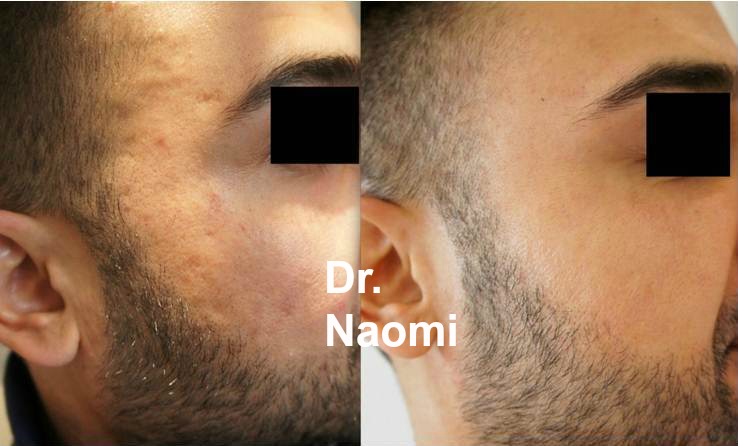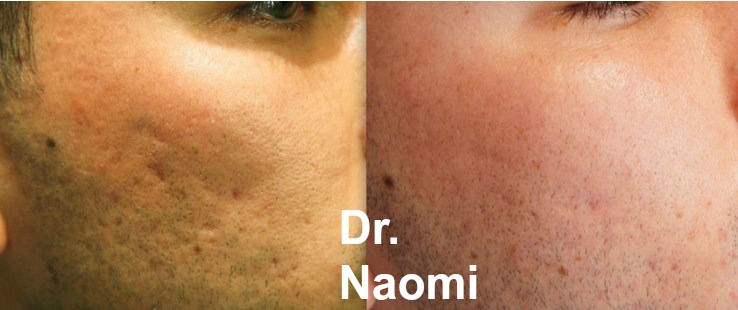
There are 2 types of fractional laser, ablative Fractional laser and non ablative Laser.
The ablative laser ablates (ie removes/vaporises the columns of skin and the non-ablative laser only heats the skin columns. Nonablative fractional laser has similar effects to those of RF microneedling devices.

What is fractional laser?
Fractional laser differs from full field laser. Full field laser removes the whole surface area of the treatment site (eg in a Microlaser Peel). Fractional ablative laser vaporises (removes) thousands of channels into the skin, covering only a fraction of the surface area of the treatment site. This action activates the body’s wound healing mechanisms, but leaves the surrounding skin intact, so that rapid healing is possible.
Who should have fractional laser?
- Anyone who would like to rejuvenate their skin
- Those with acne scarring
- Those with pigmentation, epidermal melasma
How does fractional laser work?
The fractional laser creates micro channels in the skin, the heating the tissue in these columns causes fibroblast and collagen production. This leads to increased skin thickness, decreased pore size and number, decreased pigmentation.
What are the side effects/risks of Fractional Laser?
Hyperpigmentation / PIH (Post inflammatory hyperpigmentation) Increased skin pigmentation. This tends to occur in patients with darker skin tones. If a patient is predisposed to PIH, then they should be on a lightening agent prior to and after treatment to reduce the likelihood of PIH occurring. Topical steroid may also be prescribed by the doctor after the treatment to reduce the likelihood of PIH
Hypopigmentation (decreased skin pigmentation) The deeper the treatment, the greater the likelihood of this occurring. This is uncommon in full facial resurfacing at mild to moderate depths. Hypopigmentation in a very small area is likely when removing a deep benign mole/naevus.
Scarring: Very uncommon
Infection: Cold sore (herpes virus) and bacterial infections are possible. Antivirals may be prescribed preventatively. Antibiotics may be required if a bacterial infection occurs
Acne eruption: This is uncommon, but can occur in patients who are predisposed to getting acne
“Gridding”: This is uncommon, and where the area where the laser has ablated the tissue can be seen for an extended time period. It is difficult to pick up on photography as it is usually very minor
THE PROCEDURE FOR FRACTIONAL ABLATIVE LASER
Consultation:
- The patient will have a consultation with the doctor, nurse or laser therapist
- A history will need to be taken, including history of other treatments, complications, skin type and history of cold sores.
- Examination of your skin and what needs to be required.
- Photographs of your skin will be taken
- Consent form will be read and signed, with opportunity for further discussion
- If the patient is predisposed to PIH, a lightening agent would be prescribed. Sometimes this is required for 2 weeks prior to procedure. In this case, test patching may also be required
The Fractional Laser Procedure
- The patient arrives 1 hour before the procedure
- A topical anaesthetic will be applied for 1 hour prior to the procedure with glad wrap.
- The patient’s face will be cleaned and the treatment will take place. The treatment will take about half an hour to 45 minutes.
- It is mildly uncomfortable, and happy gas is available, but most patients do not request it.
How many treatments of fractional laser will I need?
- For acne scarring, we recommend a minimum of 5 treatments
- For epidermal melasma, typically we recommend 2-3 treatments
- For rejuvenation, patients can typically be satisfied after between 1 and 5 treatments.
The important thing to consider when having fractional laser, is that fractional laser, by definition, is not covering the full surface area of the skin, so the results are limited by that fact, hence the fact that multiple treatments will be required. My most typical coverage when we’re using fractional laser on the face is 11%. Which means that we are only ablating 11% of the patient’s skin, so there is really only potential for around 11% improvement at best.
Fractional Laser Non-Ablative


Before and after multiple treatments for acne scarring including fractional laser, dermal filler and skinbooster

What is non-ablative fractional laser?
Fractional laser differs from full field resurfacing. Full field resurfacing removes the whole surface area of the treatment site (eg in a Microlaser Peel). Fractional laser heats up thousands of channels into the skin, covering only a fraction of the surface area of the treatment site. This action activates the body’s wound healing mechanisms, but leaves the surrounding skin intact, so that rapid healing is possible.
Who should have fractional laser?
- Anyone who would like to rejuvenate their skin
- Those with acne scarring
- Those with pigmentation, epidermal melasma
How does fractional laser work?
The fractional laser creates micro channels in the skin, the heating the tissue in these columns causes fibroblast and collagen production. This leads to increased skin thickness, decreased pore size and number, decreased pigmentation
THE PROCEDURE FOR FRACTIONAL NON-ABLATIVE LASER
Consultation:
- The patient will have a consultation with the doctor, nurse or laser therapist
- A history will need to be taken, including history of other treatments, complications, skin type and history of cold sores.
- Examination of your skin and what needs to be required.
- Photographs of your skin will be taken
- Consent form will be read and signed, with opportunity for further discussion
- If the patient is predisposed to PIH, a lightening agent would be prescribed. Sometimes this is required for 2 weeks prior to procedure. In this case, test patching may also be required
The Non-ablative Fractional Laser Procedure
- The patient arrives 1 hour before the procedure
- A topical anaesthetic will be applied for 1 hour prior to the procedure with glad wrap.
- The patient’s face will be cleaned and the treatment will take place. The treatment will take about half an hour to 45 minutes.
- It is mildly uncomfortable, and happy gas is available, but most patients do not request it.
What is the downtime required
The skin will be red immediately after the treatment. Most patients choose to go to work the day after non-ablative fractional laser. Very rarely there might be swelling the day after, particularly if multiple passes are used on the under eye area. The skin can be a little rough and dry for a few days after.
How many treatments of non ablative fractional laser will I need?
- For acne scarring, we recommend a minimum of 5 treatments
- For epidermal melasma, typically we recommend 2-3 treatments
- For rejuvenation, patients can typically be satisfied after between 1 and 5 treatments.
The important thing to consider when having fractional laser, is that fractional laser, by definition, is not covering the full surface area of the skin, so the results are limited by that fact, hence the fact that multiple treatments will be required. My most typical coverage when I’m using my fractional laser on the face is around 10%. Which means that we are only treating about 10% of the patient’s skin, so there is really only potential for around 10% improvement at best.